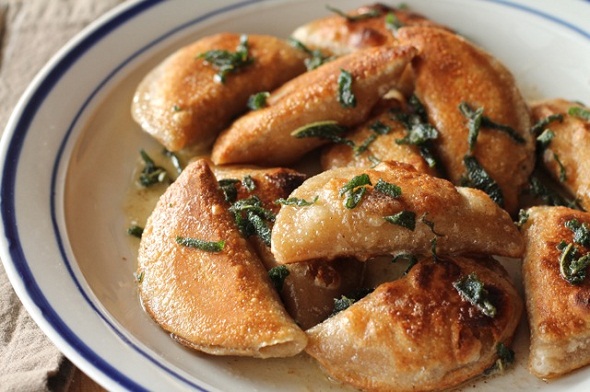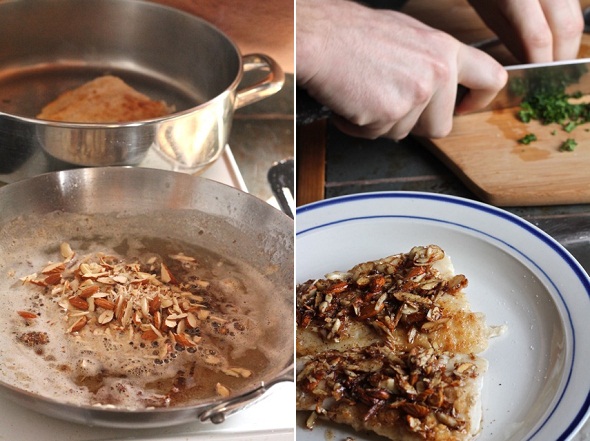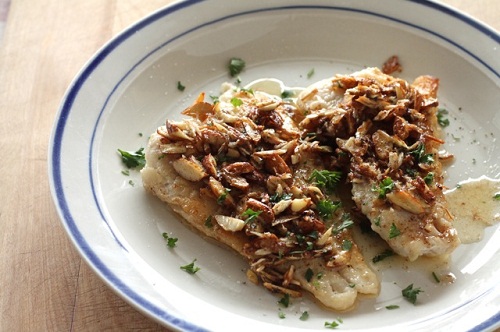 You can serve perogies with any kind of sauce or none at all, they're amazing on their own. For this recipe, I went with a sage butter sauce because, well, it's just ridiculously good. Making your own perogies from scratch is quite a process, but you can always make double the recipe and freeze the surplus. Either way, the time you spend making perogies is definitely time well spent.
Flour-wise, I go with Speerville Flours. Their whole white unbleached flour has a depth of flavor commercial flours just don't have. Unbleached flower is less processed and contains more of the original wheat kernel, making it healthier and darker in color. I just love the stuff!
You can serve perogies with any kind of sauce or none at all, they're amazing on their own. For this recipe, I went with a sage butter sauce because, well, it's just ridiculously good. Making your own perogies from scratch is quite a process, but you can always make double the recipe and freeze the surplus. Either way, the time you spend making perogies is definitely time well spent.
Flour-wise, I go with Speerville Flours. Their whole white unbleached flour has a depth of flavor commercial flours just don't have. Unbleached flower is less processed and contains more of the original wheat kernel, making it healthier and darker in color. I just love the stuff!

Yields about 24 perogies
Serves 4
Filling
• 2 medium potatoes, peeled and roughly chopped
• 1 1/2 cup grated aged cheddar
• chives and/or parlsey, finely chopped
• pinch of salt
Boil the potatoes until thoroughly cooked, about 15-20 minutes.
Strain them and let stand for 5 minutes to let the extra moisture out.
Mash and add the cheddar, butter, herbs and salt. Your filling is done.
ps: Don't throw out your potato skins; put them in a pan with oil + salt and in the oven at 400F for 20 minutes. You'll have nice, crispy potato chips to munch on.
Dough
• 2 cups white flour
• 1/2 cup sour cream
• 3 tablespoons butter, melted
• 1 large egg
• pinch salt
Mix all the ingredients together with your hands or a mixer until you have a smooth dough. If needed, you can loosen it up with a couple drops of cold water.
Let cool for 30 minutes.
Assembly
Roll out half of the dough to about 1/8" thick. With a glass or dough cutter, cut out 3" circles, saving the trims.
Put about 1/2 tablespoon of filling in the middle of each.
Dip your finger in water and pass it around the edges so the dough will stick together nicely.
Close the perogies making sure they are completely sealed. Set them aside on a pan.
Repeat the process with the other half of the dough.
Form a ball with the trimmings, roll and make some more.
At this point you can put them in a bag with a dash of flour and freeze them.

Cooking
Bring a pot of water to a boil, adding a teaspoon of salt.
Drop about half of the perogies in and cook for 5-6 minutes or until they float on the surface.
Remove from water and put on a plate with a paper towel to dry them.
Cook the rest of the perogies the same way.
Frying
In a saute pan heat up 2 tablespoons of oil. Once it's sizzling, fry some perogies for 2-3 minutes on each side.
Serve hot.
Sage Butter Sauce
• 1/4 cup butter
• 8-10 sage leaves, chopped
• 1 tablespoon lemon juice
In a small sauce pan melt the butter on medium heat. Let it bubble until it browns just a bit.
Add the sage, remove from heat and add the lemon juice.
If you used unsalted butter, season with salt.

 Raw oysters on the half shell are quite the thing, but I also relish mine cooked. For this recipe, I filled the opened shells with chive butter (chives were the first to come up in the garden) and aïoli. The aïoli once heated becomes something between a holandaise and a creamy cheese. But you can also skip the baking and serve the oysters raw with the same ingredients. Either way, the flavours are terrific, so it's up to you!
Raw oysters on the half shell are quite the thing, but I also relish mine cooked. For this recipe, I filled the opened shells with chive butter (chives were the first to come up in the garden) and aïoli. The aïoli once heated becomes something between a holandaise and a creamy cheese. But you can also skip the baking and serve the oysters raw with the same ingredients. Either way, the flavours are terrific, so it's up to you!


 I wanted to make a lobster roll that you could actually roll. I have nothing against the classic hot-dog bread buns, but I figured flatbreads are so easy to make, why not give those a whirl? My preferred way to eat lobster is straight up with a squeeze of lemon and soaked in garlic butter. Simple but effective. It's the same here, but rolled in a flatbread.
Also check out:
I wanted to make a lobster roll that you could actually roll. I have nothing against the classic hot-dog bread buns, but I figured flatbreads are so easy to make, why not give those a whirl? My preferred way to eat lobster is straight up with a squeeze of lemon and soaked in garlic butter. Simple but effective. It's the same here, but rolled in a flatbread.
Also check out:


 Sole Amandine is a very old French classic, but, as we can all appreciate, the recipe is a simple one. Essentially, the dish is pan-seared filet of fish with a sauce of browned butter, almonds, and lemon. What I love about the recipe is that it works amazingly well with any type of fish; trout, haddock, tilapia - you name it. I had haddock in the fridge, so I went with that. But, you can also get creative - give your next batch of asparagus an amandine kick. The earthy sweetness of browned butter, the crunch of almonds, and the crisp, zesty taste of lemon go so well together, but the effect is still gentle enough to compliment a variety of core flavors. Try it out and enjoy!
Sole Amandine is a very old French classic, but, as we can all appreciate, the recipe is a simple one. Essentially, the dish is pan-seared filet of fish with a sauce of browned butter, almonds, and lemon. What I love about the recipe is that it works amazingly well with any type of fish; trout, haddock, tilapia - you name it. I had haddock in the fridge, so I went with that. But, you can also get creative - give your next batch of asparagus an amandine kick. The earthy sweetness of browned butter, the crunch of almonds, and the crisp, zesty taste of lemon go so well together, but the effect is still gentle enough to compliment a variety of core flavors. Try it out and enjoy! Serves 2
One filet is usually enough for two people. Adjust depending on the size of your fish.
Serves 2
One filet is usually enough for two people. Adjust depending on the size of your fish.
 You can serve perogies with any kind of sauce or none at all, they're amazing on their own. For this recipe, I went with a sage butter sauce because, well, it's just ridiculously good. Making your own perogies from scratch is quite a process, but you can always make double the recipe and freeze the surplus. Either way, the time you spend making perogies is definitely time well spent.
Flour-wise, I go with
You can serve perogies with any kind of sauce or none at all, they're amazing on their own. For this recipe, I went with a sage butter sauce because, well, it's just ridiculously good. Making your own perogies from scratch is quite a process, but you can always make double the recipe and freeze the surplus. Either way, the time you spend making perogies is definitely time well spent.
Flour-wise, I go with 

